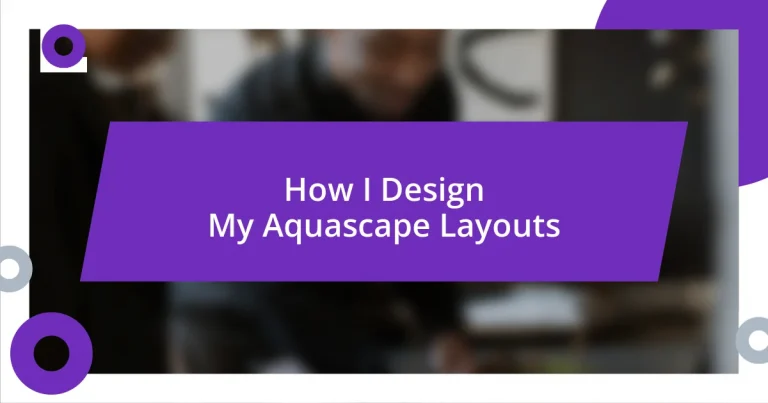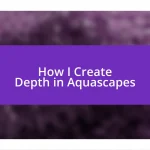Key takeaways:
- Understanding the basics of balance and composition, like the Rule of Thirds, is essential for creating visually appealing aquascapes.
- Choosing the right aquarium size impacts maintenance, aesthetics, and the overall health of the ecosystem, with different sizes offering unique benefits and challenges.
- Incorporating various textures and colors, alongside proper plant placement and maintenance practices, enhances the beauty and longevity of an aquascape.
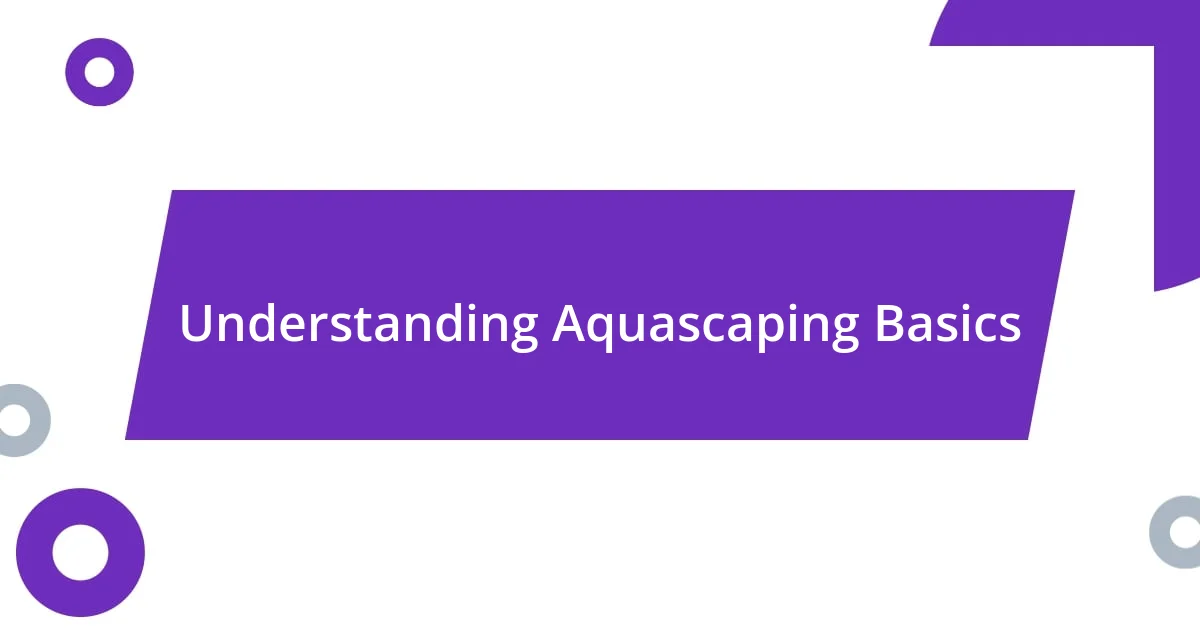
Understanding Aquascaping Basics
When I first dipped my toes into aquascaping, I was amazed to learn how essential the layout’s balance is. It’s not just about placing plants or stones together; it’s about creating harmony that draws the eye without overwhelming it. Have you ever stepped back from your setup and felt something was off, despite every element being beautiful on its own?
Understanding the basic principles of composition, such as the Rule of Thirds, has been a game changer for me. This rule suggests that important elements should be positioned along imaginary lines dividing your layout into thirds, making it more visually appealing. I remember my initial struggles with this concept; I was so eager to fill every corner that I forgot to leave space for the eyes to rest. Now, I approach my designs with a more thoughtful mindset.
The choice of plants and decorations can greatly influence not just aesthetics, but also the aquarium’s health. I relish the challenge of selecting flora that thrive both in harmony with each other and in the water conditions I’ve set. Isn’t it fascinating to consider how the right plant can enhance both the beauty of the layout and the ecosystem’s balance? Understanding these basics has truly transformed my approach to aquascaping.
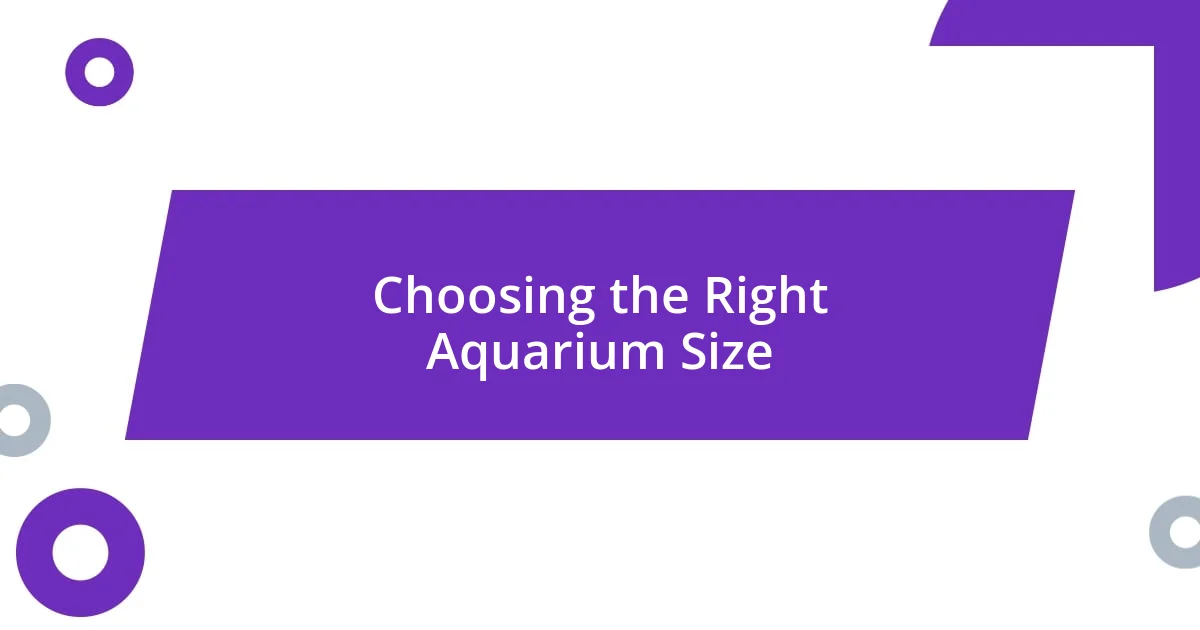
Choosing the Right Aquarium Size
Choosing the right aquarium size can be quite a journey in itself. I remember when I was deciding on my first tank; I felt overwhelmed yet excited. I quickly realized that the size of the aquarium directly impacts every aspect of aquascaping—from the plant choices to the fish compatibility. A smaller tank may seem charming, but it comes with its own set of challenges, like maintaining stable water chemistry.
In my experience, each size comes with pros and cons that must be weighed carefully. For instance, a larger aquarium allows for more diverse aquatic life and a richer scape, but it requires more maintenance. Conversely, smaller tanks can fit in limited spaces, making them ideal for apartments, yet they demand a more hands-on approach to avoid sudden fluctuations. Have you ever had to make a tough choice about tank size? It definitely forces you to think about your goals and lifestyle.
Here’s something I’ve learned: it’s not just about the aesthetics. The right size influences the overall balance of the ecosystem. A bigger tank gives you the flexibility to create complex layouts, while a smaller one can push you to be creative with limited resources. Personally, I found that my love for aquascaping flourished once I settled on a size that matched both my vision and my ability to maintain it.
| Aquarium Size | Pros | Cons |
|---|---|---|
| Small (10-20 gallons) | Space-efficient, less expensive | Less stable water conditions, limited stock |
| Medium (20-55 gallons) | Good balance between space and complexity | Moderate maintenance, more initial cost |
| Large (55+ gallons) | Extensive aquatic choices, stable environment | Higher maintenance, larger footprint needed |
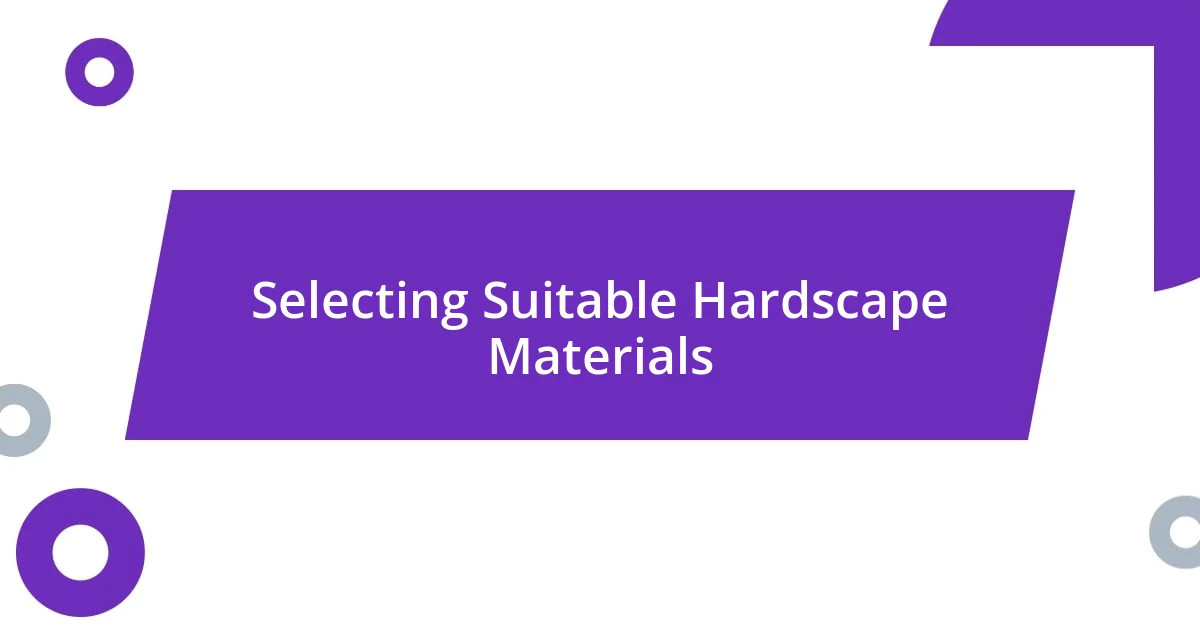
Selecting Suitable Hardscape Materials
When selecting suitable hardscape materials for my aquascape, I always go for a mix of textures and colors to create depth and interest. I vividly recall the first time I used driftwood in my layout—the way it added character was transformative. I leaned on nature’s design, often choosing rocks and wood that mimicked the environments I admired in nature documentaries. The materials I select not only shape the aquascape’s appearance but also its functionality, providing hiding places and swim-throughs for my fish.
Here are some factors I consider when choosing hardscape materials:
- Material Type: Whether it’s driftwood, stones, or ceramics, each provides unique aesthetics and functionality.
- Water Compatibility: I always check if the materials are safe for the aquatic environment, ensuring they won’t alter water chemistry.
- Weight and Size: Heavier materials need to be placed before I fill the tank, so I can rearrange without worry later.
- Natural Look: I prefer materials that replicate nature, as they blend seamlessly with plants and enhance the overall design.
- Personal Connection: Sometimes, I pick elements that remind me of my favorite hiking spots or travels, infusing a sense of nostalgia into the layout.
In my experience, the right hardscape can be the backbone of your design. The last time I set up my tank, I returned to a favorite local river and collected some smooth stones. They not only brought back memories but also perfectly fit the theme I wanted to create. Balancing aesthetics with practicality helps me achieve that harmonious feel I aim for in each layout. It’s about that visceral connection—finding materials that can tell a story while serving a purpose.
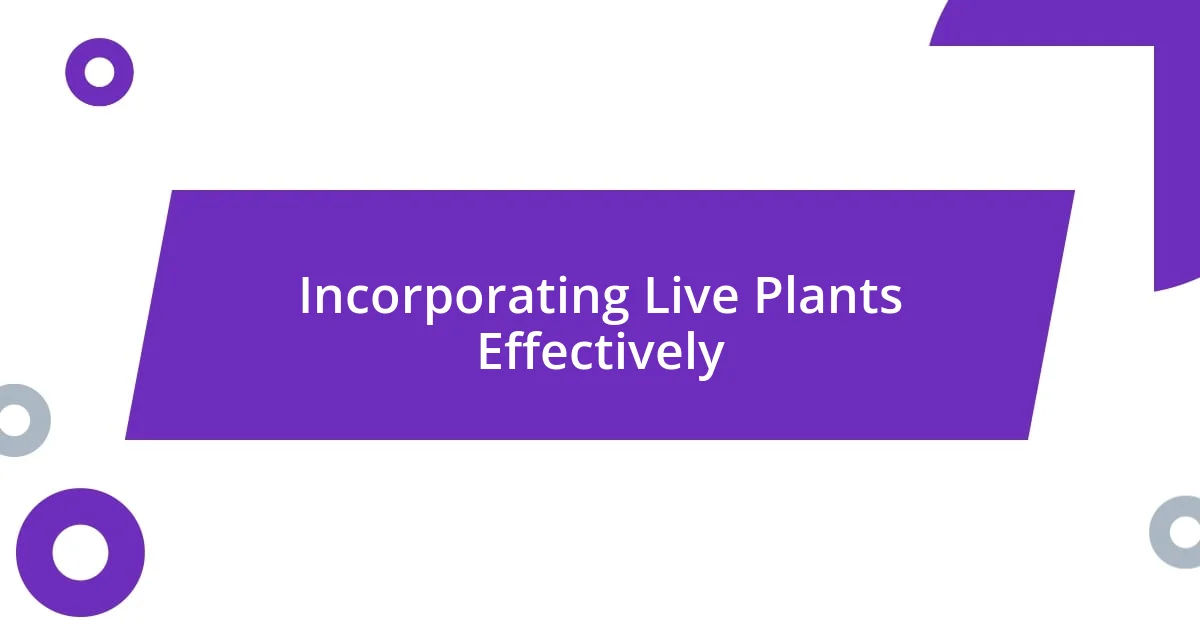
Incorporating Live Plants Effectively
Incorporating live plants into my aquascape has always felt like adding a heartbeat to my underwater world. I love how each plant contributes a different shade of green, texture, and movement, creating a vibrant ecosystem. For example, when I introduced my first Anubias, I was amazed by how it thrived even in lower light conditions. Have you ever been surprised by the resilience of a plant you thought would struggle? It creates such a dynamic atmosphere.
One key aspect I’ve learned is the importance of plant placement. I typically start with taller plants in the back, gradually transitioning to shorter ones at the front. This layering effect draws the eye into the tank, allowing each plant to shine without overwhelming its neighbors. A few months back, I decided to give my tank a refreshing makeover and rearranged my Cryptocoryne. The way it opened up the space felt like breathing new life into the design, reminding me how vital strategic positioning is.
I also pay close attention to the compatibility of the plants with the tank’s conditions, such as light and water parameters. For instance, knowing that my Java Fern thrives in the same gentle water flow as my bettas gives me peace of mind. It’s rewarding to create a space where both plants and fish coexist harmoniously. When plants flourish, it’s like the whole aquascape comes to life, a reminder that nature has its own unique rhythm. What has your experience been with plant selection? It truly can transform the entire feel of your aquarium.

Creating Depth and Perspective
Creating depth and perspective in an aquascape is like painting a three-dimensional landscape under water. I often imagine a distant mountain range when laying out my hardscape, with larger stones placed at the back to mimic those towering peaks. You know, the feeling of standing at the base of a scenic vista? That’s what I aim to evoke; it pulls the viewer in and gives the tank a sense of grandeur.
One technique I’ve found incredibly effective is using varying heights and layers. During my last aquascaping session, I placed some taller plants at the back while integrating a gently sloping rock formation that led to smaller stones in the front. This layering creates not just the illusion of depth but also enhances the overall dimensionality of the scene. Have you ever tried arranging your materials from biggest to smallest? It’s fascinating how that simple trick can transform your aquarium into a captivating narrative.
When I look at my aquascapes, I appreciate the interplay of light and shadow created by depth. Last summer, I watched how the sunlight cascaded through my floating plants, casting intricate patterns on the substrate below. This dynamic element not only adds life but reinforces the depth I crave. How have you used light in your own design? Each moment brings a new perspective, reminding me that our underwater landscapes are ever-evolving masterpieces.

Balancing Color and Texture
Balancing color and texture in an aquascape requires a thoughtful approach; it’s about creating harmony that pleases the eye. I often start by selecting a color palette that reflects my mood or theme for the tank. For example, during a particularly stressful week, I opted for rich reds and deep greens, finding solace in this warm combination as I watched my plants flourish. Have you ever noticed how certain colors can shift your emotions?
When it comes to texture, I love to mix smooth-leaved plants with those that have a more rugged or feathery appearance. This interplay adds complexity and invites viewers to explore the landscape more intimately. I remember the thrill of pairing my lush Vallisneria with some delicate Cabomba—the juxtaposition made each plant’s features stand out beautifully. What textures have you found that enhance your aquascape’s visual interest?
I believe it’s crucial to maintain balance, so I make sure not to overwhelm the viewer with clashing colors or contrasting textures. A few months ago, I introduced some vibrant red moonwort into my setup but placed it alongside soft mosses and darker stones to ground the composition. Observing how everything settled into place was a moment of pure joy for me. Have you realized how much a single element can change the entire vibe of your aquarium? It’s such an enriching experience to strike that perfect balance!
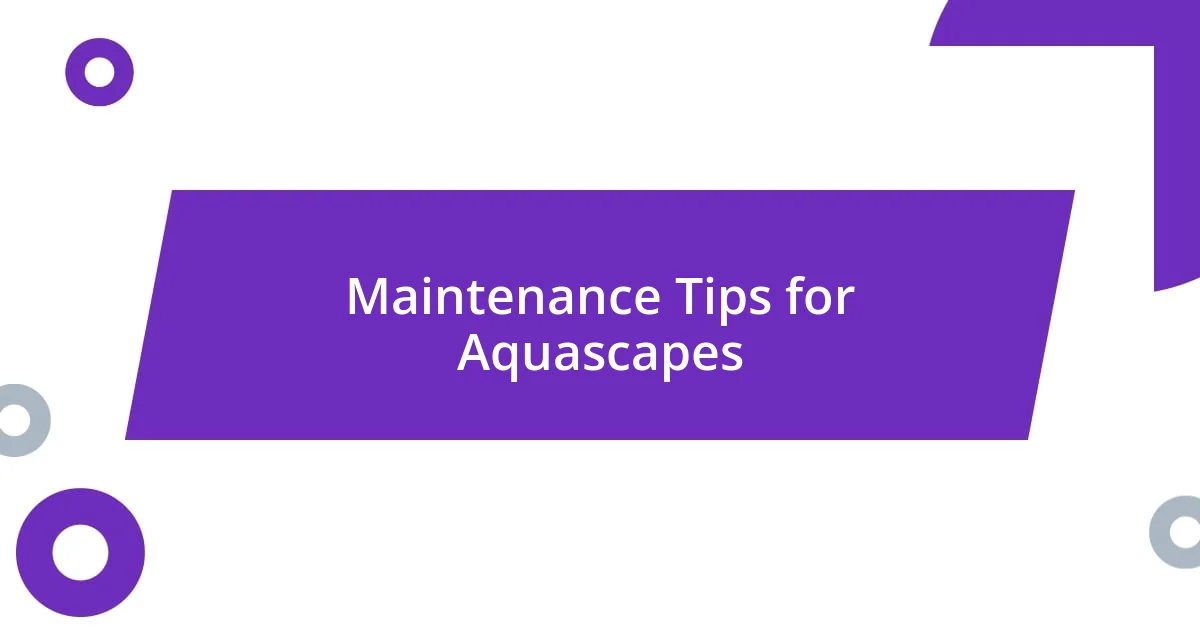
Maintenance Tips for Aquascapes
Maintaining an aquascape is crucial to its longevity and beauty. Regular water changes are essential; I typically change about 20% of the water weekly. It might seem minor, but this simple act helps remove toxins and keeps my plants flourishing. Have you ever noticed how refreshing it feels to see your water crystal clear just after a change?
I also swear by trimming my plants consistently. It’s not just about aesthetics; it promotes healthy growth and prevents overpopulation. The pruning process can be quite therapeutic. Last week, as I snipped back some overreaching stems, I lost myself in the rhythm of the task, feeling a sense of accomplishment with each trimming. Have you tried making it part of your routine too?
Finally, paying attention to algae is key. I’ve found that a dedicated cleanup crew—like shrimp or snails—works wonders in keeping things in check. When I introduced my first batch of Amano shrimp, it was fascinating to watch them scuttle around, feasting on algae like little garden helpers. Have you thought about which critters could enhance your tank’s ecosystem? Their presence not only helps maintain balance but adds another layer of life to your aquascape.












